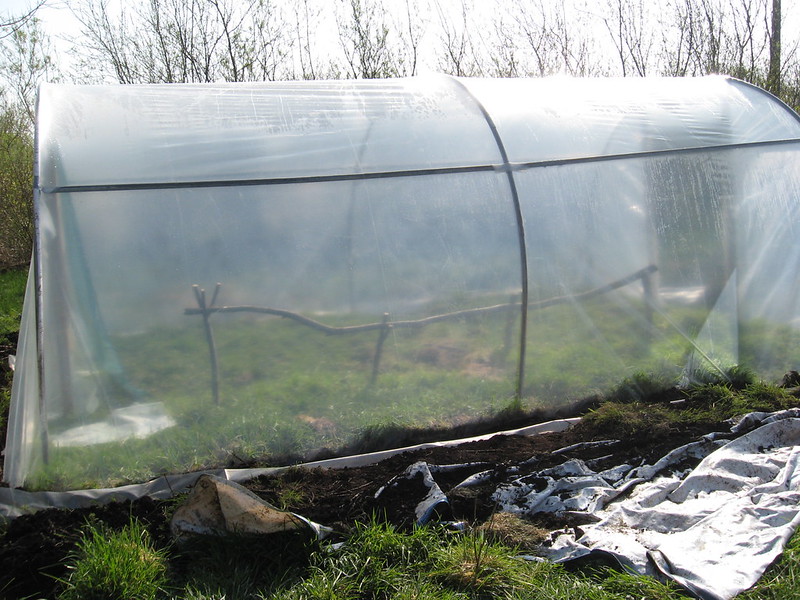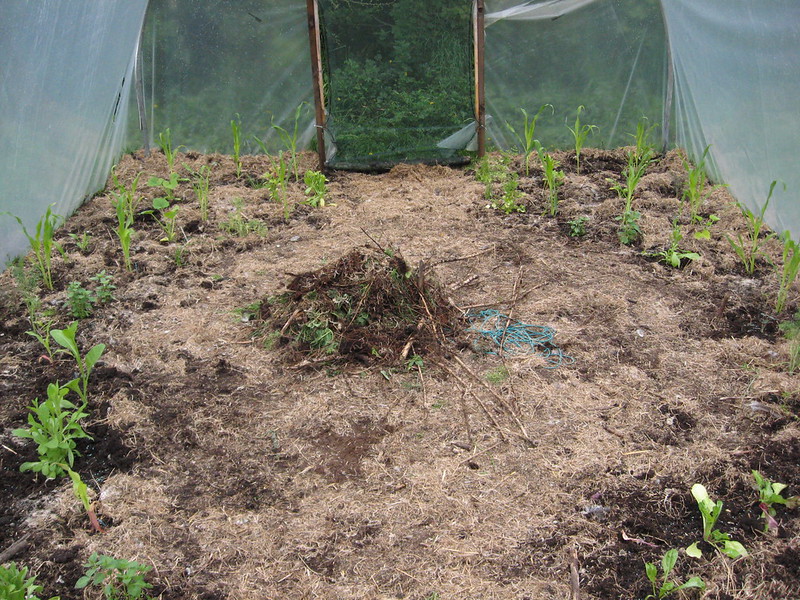


|
Commenced:
|
01/01/1995 |
|---|---|
|
Submitted:
|
24/05/2012 |
|
Last updated:
|
15/10/2021 |
|
Location:
|
Clogher, Kilfenora, Co. Clare, IE |
|
Climate zone:
|
Cool Temperate |
(projects i'm involved in)
Project: Sailchearnach
Posted by Ute Bohnsack about 13 years ago
The Irish climate can be a bit of a challenge. Even though one can come across palms, tree ferns, Eucalyptus, Arbutus unedo, figs and other frost-tender plants here and there in sheltered locations, town gardens, walled gardens and the like in this country, growing tomatoes, peppers, sweetcorn, basil, eggplant outdoors is almost impossible except in the most unusual of summers. Last year even my friend's courgettes up the road failed outside, and she is a savvy gardener. We may not get much frost but we get a lot of rain and not much sun or summer heat, prompting the joke, "Last year the summer fell on a Monday.". So a polytunnel (hoophouse) or glasshouse is pretty much indispensible for anything beyond the staple spuds, cabbages, carrots and onions. As if to prove the point, yesterday - the second official day of summer - we had a max. temp. of 16.7C (62F) and more than an inch of rain...
We were lucky to be gifted a second tunnel frame a while back and on a good day in late March Mike (Kudoz to him, he dug the trench!) and I put it up, on ground that had been grassland for, I guess, at least 150 years.
I had always wanted a second tunnel because I like sweetcorn and pumpkins and the latter tended to go rampant in our first tunnel, shading out tomatoes and other crops.
March 28, about 50 days to go until last frost date: Time for the cockerel gang to do their stuff. 
They got a perch, feeder, waterer, and an electric net to keep them safe from the foxes and allow them to spend time outside when it got too hot inside. They did a formidable job scratching and scraping, turning the grass into mulch, eating slugs, and leaving plenty of manure behind - perfect for heavy feeders like sweetcorn. Unfortunately they also did quite a bit of fighting, especially after I sold the old chaperone rooster, and punched some holes into the brandnew plastic. Just as well I still have a roll of tunnel repair tape. Starting off with 18 birds, some were sold, some butchered and the remaining 9 recently moved into another holding pen. Last frost date came and went (c. May 18) but this weekend, at last, I got around to planting out all those seedlings sitting in polytunnel #1 in their plug trays (I use root-trainer trays which give the individual plants plenty of room) waiting to spread their roots.
This is my "Three Sisters" tunnel: corn, beans and squash. So in went
» 32 x Sweetcorn (Hookers' Blue Indian, Golden Bantam), each plug of one or two plants with a runner bean or climbing French bean seed stuck in beside it (Hawkers Wonder and Old Homestead from the Irish Seedsavers Association).
» 4 x Pumpkin/Winter squash (Hokkaido, Red Kuri, Connecticut Field)
The Golden Bantam germination rate had been poor (old'ish' seed) so I had lots of space left for
» 6 x Zucchini/Courgette/Summer Squash (Early Golden Crookneck, Genovese, Burpee's Golden)
» 6 Rainbow chard
» several plugs with multiple mixed Amaranths from Salt Spring Seeds. This lovely Canadian company (no affiliation, just a happy customer) also supplied the Hookers' Blue Indian corn, a short-season variety bred in Washington state in the 1930s.
To these main crop species I added herbs and flowers for eating, to attract beneficial insects/pollinators, for their scent and not least for their colour and beauty. Lower ones and those for regular picking in front, taller ones towards the back:
2 x Borage
2 x Bronze Fennel
1 x Parsley
2 x Chives
4 x Cilantro
6 x Dill
5 x Basil (different types)
1 x Verbena bonariensis
6 x Calendula
1 x Agastache
3 x Rudbeckia
5 x Yarrow 'Cassis'
1 x Monarda citriodora (Bee balm)
1 x Malva zebrina 'Merlin'
2 x Nicotiana (Flowering Tobacco)
2 x Nasturtium 'Empress of India'
Most of these plugs contain a couple or more plants each.
All in all there are about 100 plants (not counting the multiples), plus the bean seeds, of 33 species or cultivars in a space of 4 x 6 m (c. 13 x 20 ft).

So what's with the empty space and that heap in the middle? The heap is the remnants of the little bit of weeding the cockerels had left for me to do with my trusted little Korean hand cultivator/weeder.
The space in the centre is reserved for a keyhole bed, something like this (the photo comes from the video link page http://inspirationgreen.com/keyhole-gardening.html):
Why? I wanted thermal mass storage to even out the temperature amplitude, i.e. water and/or stone, and also a CO2 source, for example a compost heap. But that all would take up quite a bit of growing space in this already quite small polytunnel. And then it came to me that this type of keyhole bed has it all: The stones/rocks to retain heat, the compost 'bin' at the centre, and growing space to boot.
So next I'll have to start gathering stones...
In memory of my Dad Harry, father of three daughters, who loved his vegetable garden and his flowers and who should have been 82 today but never even came close.
You must be logged in to comment.
Note: The various badges displayed in people profiles are largely honesty-based self-proclamations by the individuals themselves. There are reporting functions users can use if they know of blatant misrepresentation (for both people and projects). Legitimacy, competency and reputation for all people and projects can be evidenced and/or developed through their providing regular updates on permaculture work they’re involved in, before/after photographs, etc. A spirit of objective nurturing of both people and projects through knowledge/encouragement/inspiration/resource sharing is the aim of the Worldwide Permaculture Network.
 |
MemberA member is a permaculturist who has never taken a PDC course. These cannot become PDC teachers. Members may be novice or highly experienced permaculturists or anywhere in between. Watch their updates for evaluation. |
|---|---|
  |
Permaculture MatchmakerOne of these badges will show if you select your gender and the "I'm single, looking for a permaculture partner" option in your profile. |
 |
PDCPeople who claim to have taken a Permaculture Design Certificate (PDC) course somewhere in the world. |
 |
PDC VerifiedPeople who have entered an email address for the teacher of their PDC course, and have had their PDC status verified by that teacher. Watch their updates for evaluation. |
 |
PRI PDCPeople who’ve taken a Permaculture Research Institute PDC somewhere in the world. |
 |
PDC TeacherPeople who claim to teach some version of PDC somewhere in the world. |
 |
PRI TeacherWith the exception of the ‘Member’ who has never taken a PDC, all of the above can apply to become a PRI PDC Teacher. PRI PDC Teachers are those who the PRI recognise, through a vetting board, as determined and competent to teach the full 72-hour course as developed by Permaculture founder Bill Mollison – covering all the topics of The Designers’ Manual as well as possible (i.e. not cherry picking only aspects the teacher feels most interested or competent in). Such teachers also commit to focussing on the design science, and not including subjective spiritual/metaphysical elements. The reason these items are not included in the PDC curriculum is because they are “belief” based. Permaculture Design education concerns itself with teaching good design based on strategies and techniques which are scientifically provable. PRI PDC Teachers may be given teaching and/or consultancy offerings as they become available as the network grows. |
 |
Aid WorkerThe individual with this badge is indicating they are, have, or would like to be involved in permaculture aid work. As such, the individual may or may not have permaculture aid worker experience. Watch their updates for evaluation. |
 |
ConsultantThe individual with this badge is indicating they are, have, or would like to do paid permaculture design consultancy work. As such, the individual may or may not have permaculture consultancy experience. Watch their updates for evaluation. |
 |
Community ProjectCommunity projects are projects that help develop sustainable community interaction and increase localised resiliency. |